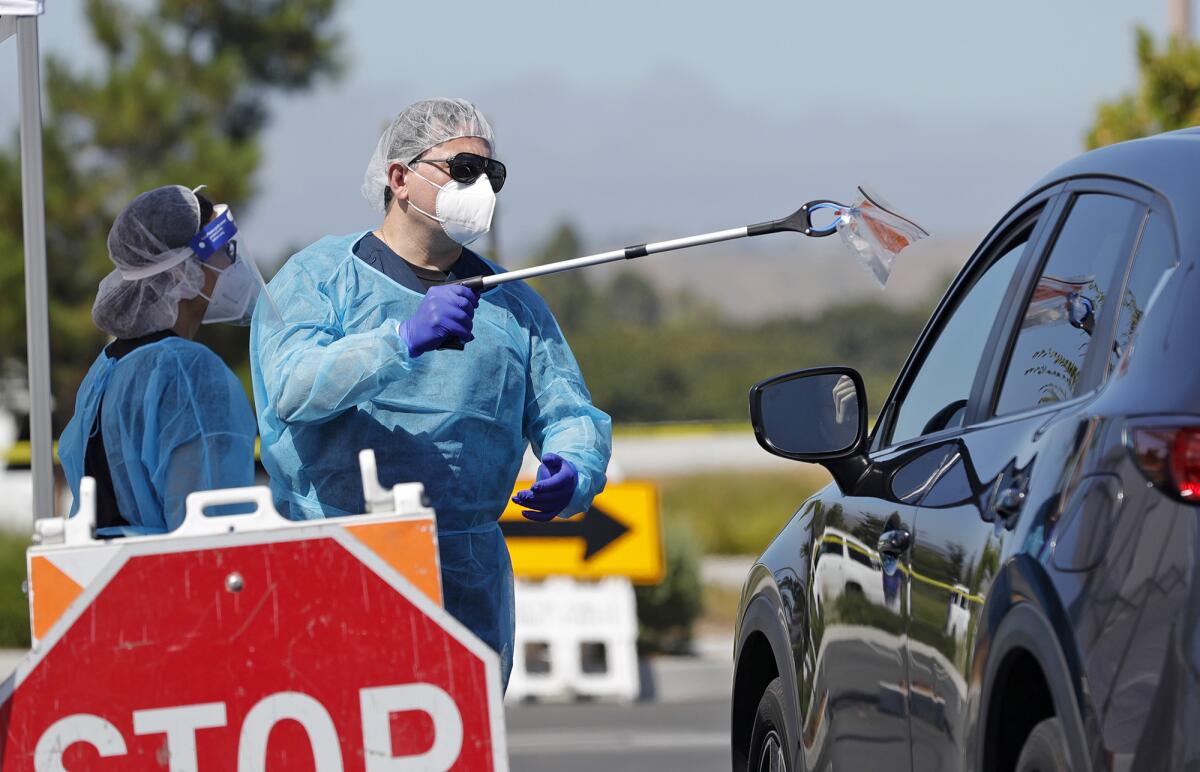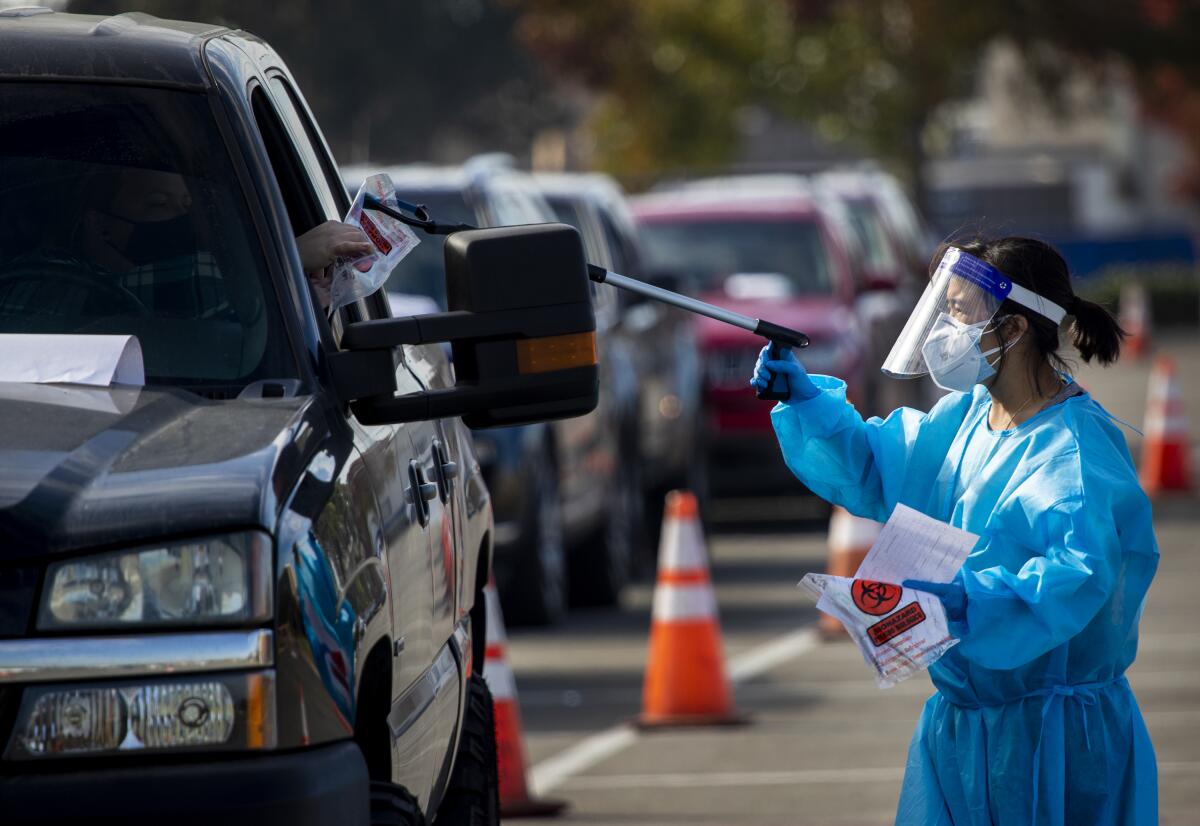Can at-home tests help Orange County get a handle on the pandemic?

Orange County residents can now test themselves for COVID-19 in the safety of their homes.
Officials this week expanded an at-home testing program to the entire county as part of a continuing move to make testing more accessible to residents.
The program began a little over two weeks ago when the county ordered 500,000 at-home tests. The first few weeks were reserved for residents of Santa Ana and Anaheim, the cities hit hardest by the virus.
“We want to make it accessible to all segments of the population,” county Supervisor Andrew Do said in an interview. “There are some who may be reluctant to go into a clinic, hospital or drive-through and have to deal with people.”
The at-home tests may help stem the worst surge of the virus yet. Like much of the state, cases of the coronavirus have skyrocketed in Orange County.
The county reported 2,613 total cases on Wednesday — the highest single-day total recorded in the county so far. Nearly 60 residents have died from COVID-19, the disease caused by the virus, in the last week.
On Thursday, the county recorded 1,521 cases and seven deaths. Only 11.3% of ICU beds were available. Orange County and the rest of the Southern California region needs to collectively get its ICU capacity above 15% in order for the lockdown to be lifted.
“People are suffering, businesses are suffering, but we should not lose sight that there are things we can do today that can determine our future,” Do said.
About 10,000 take-home tests were requested on Monday, the first day it was opened to the whole county. Do anticipates that the 500,000 tests may run out by the end of the month, at which point, the county would consider ordering more tests.
The only requirement to qualify for an at-home test is to be an Orange County resident. Tests are first-come, first-served.

The county is partnering with Aliso Viejo-based Ambry Genetics for the testing. Do said it takes about a day after ordering the test to receive it in the mail. The lab takes about one to two days to process the test.
The tests are saliva-based. Most COVID-19 tests have traditionally been nasal or nasopharyngeal swabs.
Do said the county is one of the first municipalities to use this specific kind of test. Irvine, which provides testing for its own residents, uses a mouth swab test.
Residents can order an at-home kit online or pick one up from a county clinic. The county has in-person testing at its super sites, its Latino Health Equity sites and four state-sponsored locations. Those sites will test people who live and work in Orange County.
Do said the at-home tests help make testing more accessible for the county’s residents, which is important in encouraging people to adopt regular testing as a part of their lifestyle.
“I want to have people work that into their lifestyle,” Do said. “Whether it be drive-through or going to a clinic or going online, we want to make it as free of barriers as possible.”
UC Irvine doctoral student and researcher Julia Zakashansky said at-home tests are necessary to combat the spread of the virus.
Zakashansky and UC Irvine professor Michelle Khine are currently developing an at-home saliva test for COVID-19.
The researchers developed a biosensor that recognizes and binds to the spike protein of the virus. The spike protein is what allows the virus to get into human cells.
The device would be about the size of a USB drive and contains an electrode that reacts to the DNA sequence of the spike protein. When the electrode comes into contact with a part of the sequence, it shows up as a change in current.
The device could be plugged into a phone.

“So what we’re trying to allow is for a device that you can use and read yourself, within an hour of actually collecting your saliva,” Zakashansky said, comparing it to a pregnancy test.
The research team found through laboratory tests that their method is capable of detecting very low levels of the protein, which can aid in finding the virus in early infections and asymptomatic people, Zakashansky said.
Zakashansky said companies and researchers have been working on developing saliva tests for the coronavirus since the beginning of the pandemic, but it’s a very difficult medium to work with.
Eating a cheeseburger, smoking or ingesting any other kind of food or fluid could affect a saliva test. Zakashansky said it heightens the variability between samples which could confuse a sensor.
The team still has more research to do. So far the team has just worked with the isolated spike protein. They will now need to research how their test works with the inactivated virus.
“So we are waiting to receive the inactivated virus so that we can basically redo what we did with the spike protein that was isolated,” Zakashansky said. “But this time, have the actual dead virus to see whether this device still works on a more realistic version of the antigen.”
Their method is an antigen test. Traditionally, PCR tests have been considered the gold standard in COVID-19 testing. PCR tests detect RNA, or genetic material. They are considered more accurate, but it generally takes two to three days to process the tests.
Antigen tests detect protein fragments of the virus. It takes much less time to process these tests, sometimes as little as 15 minutes.
“So antigen tests are notoriously less sensitive and accurate than those traditional PCR tests,” Zakashansky said. “And that’s why so many of these antigen tests have had a really hard time entering the market ... Our preliminary results show that we’re very, very sensitive to an extent that no one would ever expect antigen tests to be.”
Zakashansky said they don’t expect to retain that level of accuracy when exposed to real samples, but it will still likely be more sensitive than any other antigen test that has been developed so far.
Processing times can be a real impediment to stopping the spread of COVID-19. While people wait two to three days for their PCR test results, many venture out into the world, further exposing themselves and others.
PCR tests generally need to be processed in a laboratory. Antigen tests require less specialized processing, so they would be good for a timely at-home test.
“It’s hard to say with the limited amount of data so far that we’ve gotten across this pandemic, but some people are coming out with the opinion that even if a test is a little less accurate than the gold standard, it’s still better to test more frequently, than to do a really accurate test but not as frequently,” Zakashansky said. “Anything can happen within the span of a few hours.”
To sign up for an at-home test, visit oc.care.ambrygen.com/#/cit/landing.
All the latest on Orange County from Orange County.
Get our free TimesOC newsletter.
You may occasionally receive promotional content from the Daily Pilot.




